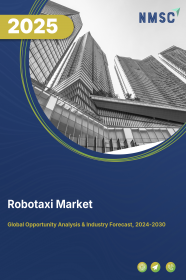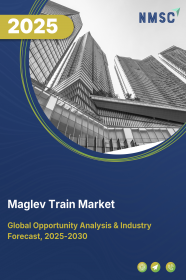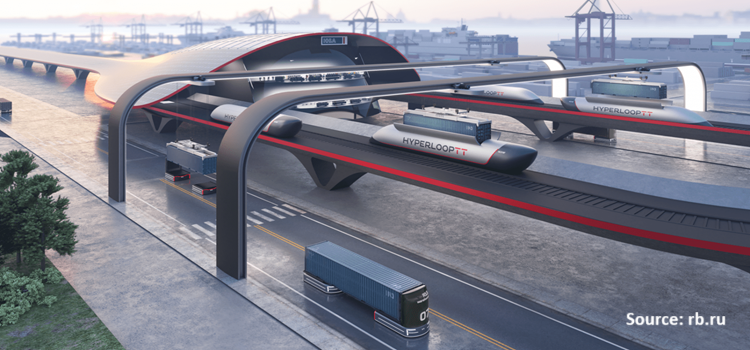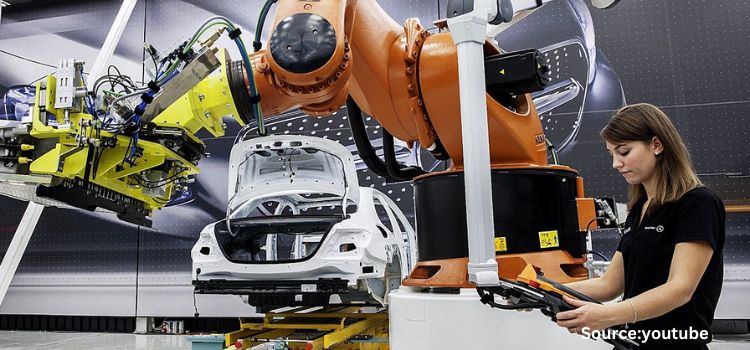
Robotaxi Market by Type (Goods, Infotainment, Passenger, and Driver Assistant), by Customer Type (Individual Customers and Enterprise Customers), by Component Type (LiDAR, RADAR, Sensor, and Camera), by Propulsion Type (Electric Vehicles, Hybrid Vehicles, and Fuel Cell), by Automation Level (Level 4 and Level 5), by Vehicle (Shuttle, Van, and Car) and Others- Global Opportunity Analysis and Industry Forecast, 2024–2030
US Tariff Impact on Robotaxi Market
Trump Tariffs Are Reshaping Global Business
Market Definition
The Robotaxi Market size was valued at USD 2.11 billion in 2023, and is predicted to reach USD 104.03 billion by 2030, with a CAGR of 74.5% from 2024 to 2030. A robotaxi is an autonomous and self-driving vehicle that operates without a human driver or intervention. It is designed to provide on-demand transportation services to passengers. These vehicles are equipped with advanced sensors, artificial intelligence (AI) algorithms, and communication systems that enable them to navigate safely, interact with traffic, and transport passengers to their desired destinations. Robotaxi represents a fundamental shift in the transportation industry by offering efficient, convenient, and potentially cost-effective mobility solutions. It also reduces the need for personal vehicle ownership and decreases traffic congestion and emissions in urban areas.
Market Dynamics and Trends
The global trend toward urbanization is driving increased demand for transportation services in cities, where robotaxis are well-suited to address the last-mile and first-mile transportation needs of residents. Also, continuous improvements in autonomous driving technology, including sensors, AI algorithms, and real-time data processing, make it safer and more reliable than before for robotaxis to operate without human intervention.
For instance, in June 2022, Hyundai announced the launch of the robotaxi trial with its own AV technology based on the internally-developed advanced driver assistance system (ADAS). This Level 4 AV technology is used to navigate safely and flexibly in complicated urban environments. Hyundai's involvement in the robotaxi industry highlights the increasing interest and progress of the market.
Moreover, changing consumer preferences are shaping the landscape of the robotaxi market. The convenience of ride-sharing platforms such as Uber and Lyft has made people used to convenient and affordable on-demand transportation services. Robotaxis, with its ability to be operated through smartphone apps and offer hands-free travel, aligns seamlessly with these evolving consumer expectations. As more people opt for hassle-free and cost-effective transportation solutions, the demand for robotaxi services is set to surge.
Additionally, governments and regulatory bodies in various regions recognize the potential benefits of autonomous transportation, including enhanced road safety and reduced traffic congestion. Consequently, they are actively working to create favorable environments for testing and deploying robotaxi fleets. They are also introducing clear and supportive regulations, offering incentives, and investing in necessary infrastructure. This, in turn, fuels the market growth of robotaxi globally.
However, the deployment of robotaxis requires advanced infrastructure, including high-definition maps, reliable 5G or 4G connectivity, and intelligent traffic management systems. Many regions lack the necessary infrastructure, which restrains the market expansion. On the contrary, advancements in the Internet of Vehicles (IoV) technology are poised to provide the robotaxi market with new growth prospects. This technology allows vehicles to gather information such as traffic updates, weather alerts, and parking availability, setting the stage for market opportunities in the future.
Market Segmentation and Scope of Study
The global robotaxi market is segmented on the basis of type, customer type, component type, propulsion type, automation level, vehicle, application, and geography. Based on type, the market is classified into goods, infotainment, passenger, and driver assistance. Based on customer type, the market is categorized into individual customers and enterprise customers. Based on component type, the market is divided into LiDAR, RADAR, sensor, and camera. Based on propulsion type, the market is segmented into electric vehicles, hybrid vehicles, and fuel cells. Based on the automation level, the market is divided into Level 4 and Level 5. Based on vehicle, the market is classified into shuttle, van, and car. Based on service, the market is bifurcated into car rental and station based. Based on application, the market is segmented into passenger and goods transport. The geographical breakdown and analysis of each of the aforementioned classifications includes regions, such as North America, Europe, Asia-Pacific, and the rest of the world (RoW).
Geographical Analysis
Asia-Pacific dominates the global robotaxi market at present, and is predicted to remain dominant throughout the forecast period. This is attributed to rising government initiatives focused on the development of autonomous cars in this region. For instance, in February 2020, a blueprint was presented by the Chinese government for developing and boosting the autonomous vehicles industry by 2025. This blueprint would ensure the production scale of vehicles capable of conditional autonomous driving and the commercialization of high-level autonomous vehicles. This includes provisions for regulatory bodies to monitor and regulate independent vehicle operations, enhancing public trust in robotaxi services.
Moreover, countries, particularly China and Japan, are at the forefront of autonomous vehicle technology development. Market leaders and startups in this region are making significant advancements in self-driving technology, contributing to the growth of the robotaxi market. For instance, in November 2021, Baidu announced the launch of its driverless taxi service Apollo Go. The internet giant aims to expand Apollo Go to 65 cities by 2025 and 100 cities by 2030.
On the other hand, North America shows substantial growth in the global robotaxi market, due to the adoption of high-end technologies, including graphics processing unit (GPU) technologies and IONIQ 5. For instance, in October 2022, Uber, a ride-sharing service provider, signed a 10-year agreement to use autonomous IONIQ 5 electric vehicles from Hyundai's Motional for their ride-hailing and delivery services. These vehicles are placed strategically in various cities across the U.S. and began providing rides to passengers in December, 2022.
Also, growing collaborations and partnership strategies by multiple manufacturers of robotaxis in this region are expected to boost the market growth. For instance, in August 2023, Cruise, a robotaxi unit of General Motors, signed a partnership agreement with two local San Francisco union chapters representing electrical workers and janitors. This partnership aims to hire and employ workers responsible for building and operating Cruise's car-charging facilities.
Competitive Landscape
The robotaxi market includes several market players, such as Tesla, Ford Motor Company, Nissan Motor Corporation, Uber Technologies, Lyft, Inc., Volkswagen AG, Daimler AG, Volvo Group, Didi Chuxing, and Baidu, Inc. These market players are adopting various strategies such as innovations and joint ventures across multiple regions to maintain their dominance in the global robotaxi market.
For Instance, In September 2023, General Motors subsidiary Cruise announced that the company is set to launch a trial of five fully autonomous electric taxis in Dubai in collaboration with Dubai’s Roads and Transport Authority (RTA).
Moreover, in August 2023, Waymo received a final approval to operate its driverless taxis in California and started charging for its driverless robotaxi service in San Francisco. The California Public Utilities Commission issued its final approval, allowing Waymo and GM’s Cruise driverless taxi services to operate around the clock in the state.
Key Benefits
-
The robotaxi market report provides the quantitative analysis of the current market and estimations through 2024-2030 that assists in identifying the prevailing market opportunities to capitalize on.
-
The study comprises a deep dive analysis of the robotaxi market trend including the current and future trends for depicting the prevalent investment pockets in the market.
-
The information related to key drivers, restraints and opportunities and their impact on the robotaxi market is provided in the report.
-
The competitive analysis of the market players along with their market share in the robotaxi market.
-
The SWOT analysis and Porters Five Forces model is elaborated in the study.
-
Value chain analysis in the market study provides a clear picture of the stakeholders’ roles.
Key Market Segments
by Component
-
Hardware
-
Software
by Vehicle Type
-
Cars
-
Vans
by Service Model
-
On-Demand Services
-
Subscription Models
by Sensor
-
LiDAR
-
RADAR
-
Ultrasonic Sensors
-
Cameras
by Autonomy Level
-
Level 4 (High Automation)
-
Level 5 (Full Automation)
by Application
-
Ride-hailing Services
-
Car Sharing
-
Public Transportation
By Region
-
North America
-
The U.S.
-
Canada
-
Mexico
-
-
Europe
-
The U.K.
-
Germany
-
France
-
Italy
-
Spain
-
Denmark
-
Netherlands
-
Finland
-
Sweden
-
Norway
-
Russia
-
Rest of Europe
-
-
Asia-Pacific
-
China
-
Japan
-
India
-
South Korea
-
Australia
-
Indonesia
-
Singapore
-
Taiwan
-
Thailand
-
Rest of Asia-Pacific
-
-
RoW
-
Latin America
-
Middle East
-
Africa
-
Key Players
-
Tesla
-
Waymo LLC
-
Cruise LLC
-
Baidu Apollo
-
AutoX, Inc.
-
Pony.ai
-
Motional, Inc.
-
Zoox
-
Beijing Xiaoju Technology Co, Ltd.
-
Nuro, Inc.
REPORT SCOPE AND SEGMENTATION:
|
Parameters |
Details |
|
Market Size in 2023 |
USD 2.11 Billion |
|
Revenue Forecast in 2030 |
USD 104.03 Billion |
|
Growth Rate |
CAGR of 74.5% from 2023 to 2030 |
|
Analysis Period |
2023–2030 |
|
Base Year Considered |
2023 |
|
Forecast Period |
2024–2030 |
|
Market Size Estimation |
Billion (USD) |
|
Growth Factors |
Urbanization fuels robotaxi revolution for last-mile mobility. Consumer preferences reshaping the robotaxi market landscape. Global recognition of autonomous transportation benefits by governments and regulatory bodies. |
|
Countries Covered |
28 |
|
Companies Profiled |
10 |
|
Market Share |
Available for 10 companies |
|
Customization Scope |
Free customization (equivalent to up to 80 working hours of analysts) after purchase. Addition or alteration to country, regional, and segment scope. |
|
Pricing and Purchase Options |
Avail customized purchase options to meet your exact research needs. |

















 Speak to Our Analyst
Speak to Our Analyst





















